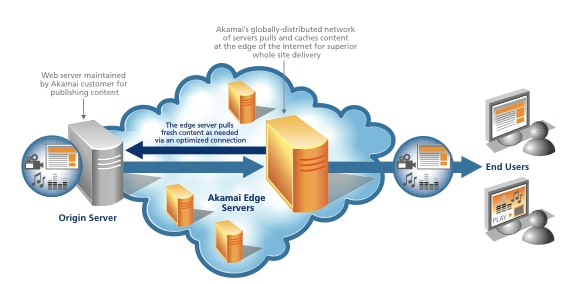And what does it have to do with Content Delivery Networks (CDNs)? Quite everything. If you consider the nature of interactive web. It is the web of frequent changes. The web that engages readers constantly. Allows comments, streams video, audio tracks, animations and so on. The dynamic content of the World Wide Web 2.0 needs to get out there faster, and remain personalized. Personalized content as well as real-time info can not be cached. Moreover, the emergence of cloud layers such as SaaS (Software as a Service), and PaaS (Platform as a Service) and so on, require more efficient models of delivering online content. Besides caching.
This is why Content Delivery Networks (CDNs) include Dynamic Site Acceleration services. Akamai, Limelight, Cotendo, all the leading CDN providers in the industry, include their own tools to accelerate dynamic content. This allows vendors to deliver highly interactive content without investing in additional hardware buildout. Or software maintenance. Finally, for them, this will translate into a better user experience created, more interactions, more clicks, better conversion rates, higher overall visibility.
The Path Fastest Travelled By
CDNs first removed to barriers to reach the end-user, posed by his geographical location. With surrogate servers allocated at different data centers, the content is delivered from the point closest to the user. No matter where he is in the world.
How One AI-Driven Media Platform Cut EBS Costs for AWS ASGs by 48%

The path chosen to retrieve the interactive content must not only be the fastest, but also most reliable. This leaves vendors with less troubles while worrying about both security (e.g. DDoS attacks, see the previous post) and their page load time. Both affect their sales revenue significantly.

Take a look at Akamai’s CDN infrastructure:
Source: www.akamai.com/dl/brochures/akamai_dsa_sb.pdf
At Akamai, they employ more than 100,000 surrogate servers within 71 different countries. While Akamai pays for hosting those servers, the vendors pay for delivering their content to end-users using this globally-distributed network of servers. But how does it all work?
- User types a URL from his browser
- A DNS request is made, i.e. browser expects an IP address in exchange for the URL of the website
- The browser then needs to contact the server with an IP address; this browser can be in China, US… anywhere in the world
- CDN copies this data in strategic geographical locations around the world
- With CDN instead of a standard hosting, the browser will call for the Edge Server included in the CDN network, nearer to the end-user. Instead of calling for the server which is further away, e.g. it will take data from US rather than China if you are making this request from US
- Sometimes, CDNs will contact the idle server, instead – but always return the best possible IP address
- If the content can’t be found in the Edge Server cache, the edge server sends request to the Origin Server to retrieve this information
- The nature of dynamic content requires repeated back and forth calls to the Origin Server (Remember, dynamic content includes a query string, i.e. “?”)
- Basically, same request will provide different results – personalized content for users. It will thus rely more on the content provider origin
- This is where Dynamic Site Acceleration (DSA) services provided by the CDN Operator come in to optimize latency and varying round-trip time of the desired content
- DSA services use more advanced DNS mapping to speed up transport of packets at the network layer
- DSA services will include better TCP algorithms that will handle the network congestion, and not lose packets
- Route Optimization packages included in the DSA services need to ensure the reliability of the connection through all parts of the route (first mile, middle mile, last mile)
- DSA will reuse HTTP connections from the edge server to the origin server and between the edge servers, rather than initiating a new connection for every request
- DSA will perform on-the-fly compression shortly after the text objects leave the origin servers: this results in less load on the origin servers to perform the compression and less data moving towards the end-user
- DSA performs the calculations and encryption for new connections, which are all compute intensive
- DSA will identify cacheable content from dynamic content
Think of all this technologies when applied to mobile device users. Allegedly, their number (of smartphone users) has recently topped 1 billion. And they expect the same capacity and bandwidth to be experienced while browsing websites. This fastest growing segment of the Internet is likely to rely on the trend of speeding up development of dynamic content acceleration technologies. Its power to be truly revealed in the future decades.






